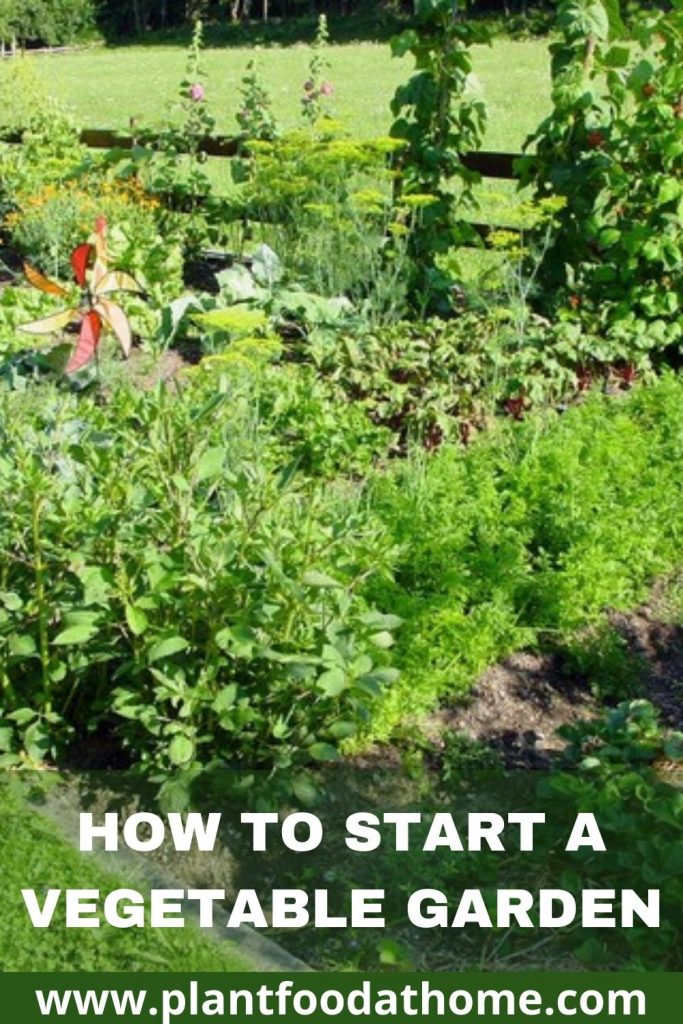Starting your own vegetable garden is a highly satisfying and cost-effective way of ensuring your family has the freshest and most wholesome vegetables to eat. You don’t need a lot of space or equipment to grow your own veggies. And nothing beats the taste of trying your first homegrown vegetables! So here is everything you need to know for how to start a vegetable garden for beginners to get you growing fresh and healthy vegetables at home.
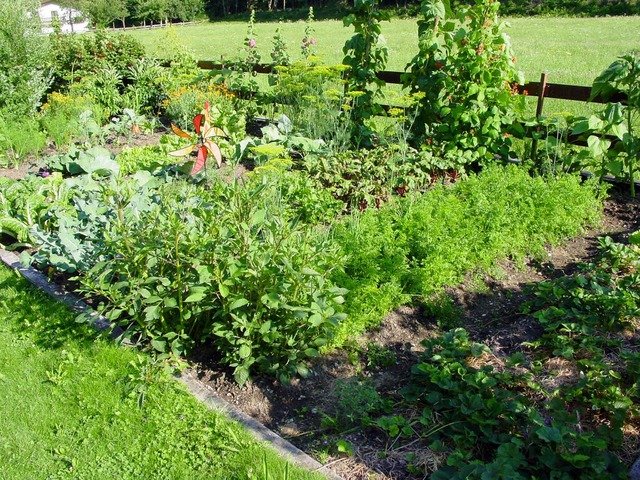
Table of Contents
- Planning a Vegetable Garden
- Vegetable Garden Size
- Drainage in the Vegetable Garden
- Traditional Dig in or Raised Vegetable Garden Beds
- Vegetable Garden Soil
- Watering Your Vegetable Garden
- What to Grow First in Your Vegetable Garden
- Seeds V’s Seedlings for Starting Your Vegetable Garden
- Weeding your Vegetable Garden
- Planting Out a Vegetable Garden
- Conclusion
- Recommended products
Planning a Vegetable Garden
My first experience of vegetable gardening was on a balcony where I grew vegetables in pots and containers. When I moved to a house, I was able to plant out all the herbs, fruit and vegetables I had always wanted to grow!
And as exciting as it is to get planting all those delicious veg, there are a few things to plan out first. Making a plan for your vegetable garden will ensure your garden will truly thrive.
The very first thing to do when starting a vegetable garden is to take a look at your yard space and watch the sun’s movement for a few days. Take note of the direction of the prevailing wind so you know the windiest parts of your garden. Taller plants will require positioning with consideration to the direction of winds that could blow them over. I’m thinking of beans here, and also herbs such as dill can grow fairly tall.
Most vegetables require light and warmth to grow, some more than others. So paying attention to your yard now will help you achieve a flourishing vegetable garden in the long run.
The area you select should maximize the sunlight and not be shaded for long periods of time. Veggies love full-sun and 6-8 hours a day is ideal. However, some shade is well tolerated in hot, dryer locations and climates.
Ideally, you also want to create a vegetable patch on a flat area. Otherwise, water will run off one end too quickly and could pool at the other end, becoming a soggy mess.
Vegetable Garden Size
Once you have chosen the ideal location for your vegetable garden or beds, next it’s time to measure out the area and decide how you will arrange it.
Many people are tempted to build a large vegetable garden with grand plans for harvesting all their fruit and vegetables from the garden next week. It’s easy to get carried away and over-commit yourself with the amount of effort it requires to maintain.
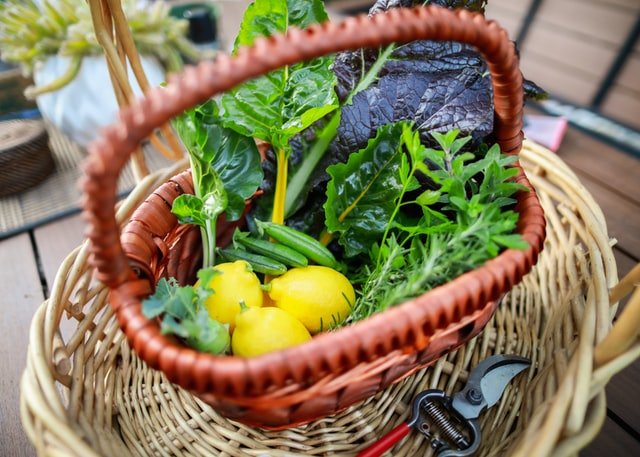
So, if you are new to gardening, it is a better idea to start out small, leaving space to expand your veggie garden if you want to in the future.
Ideally, three smaller garden beds with space to walk in between and around them is the perfect start to a vegetable garden adventure.
It’s always a good idea to actually measure and sketch the area and spend a little time thinking about how different options will work for you.
Planting a few vegetables that you love to eat or those that are difficult to find in the shops is a good starting point for the first year.
Drainage in the Vegetable Garden
Think about the space in your yard and decide if it’s a very fast draining location, slower but quite fast known as ‘free draining’ or a place that holds water and stays wet. To succeed with your vegetable garden, you want to provide the best possible conditions for your vegetables to grow.
Most vegetables grow best in free-draining soil, so ideally you want to provide these conditions.
Traditional Dig in or Raised Vegetable Garden Beds
Before you start to prepare your vegetable garden or vegetable beds, it’s a good idea to check the quality and type of the existing soil.
If your yard is hard compacted soil or interspersed with rubble, then you are a prime candidate for putting in raised beds.
Another reason that raised beds may work better is for ease of working; managing raised beds is more back-friendly than traditional dig in methods. Raised garden beds are perfect for a no-dig vegetable garden, and because you add the ideal conditions, they are easier to manage.
There is no right or wrong, just preferences based on individual circumstances.
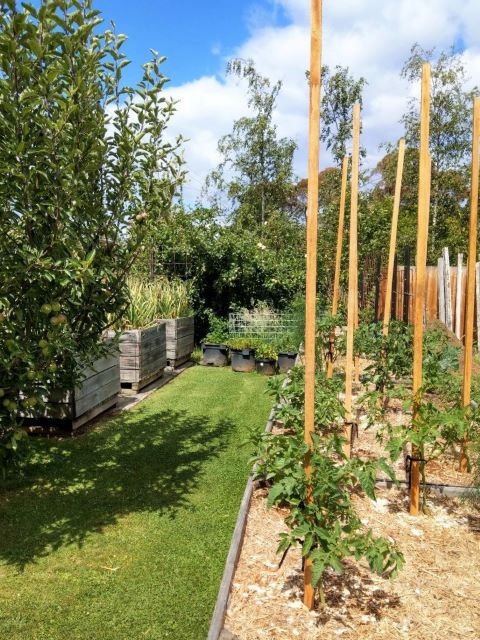
Traditional Vegetable Garden – Digging In
Supposing you are starting a dig in or traditional vegetable garden, to get started, mark out the area.
If you are digging up good grass that could be used elsewhere, slice it about an inch under the surface; you want it to resemble the turf that you can buy. A useful tool to borrow or hire is a motorized tiller that will turn over the soil for you. Alternatively, turn the soil by hand with a garden spade.
Assess the soil and if it’s very sandy; add additional compost or well-rotted manure for water retention. If it is clay-based; you will still need to add compost or well-rotted manure, and add some sand, vermiculite or perlite to increase the looseness and drainage of the soil.
Because you will need to walk on the vegetable garden, some of the prepared soil will be lost, although one way to counterbalance that is to apply compost only to the planting rows. Compacting the soil by walking on it is not healthy for the vegetables. It is the enemy of getting the best from the soil and maximizing yields. Each time you tread on the soil for weeding, planting and cropping, you will further compact the soil, which can impact water retention and drainage.
A great idea is to apply mulch to the areas that you will walk on. It will help reduce the impact twofold by maintaining moisture and keeping weeds down, so you also walk on it less.
The main advantage of this traditional method of digging in vegetable gardening is the low cost, both financial and time spent getting started.
Raised Bed Vegetable Gardening – Building on Top
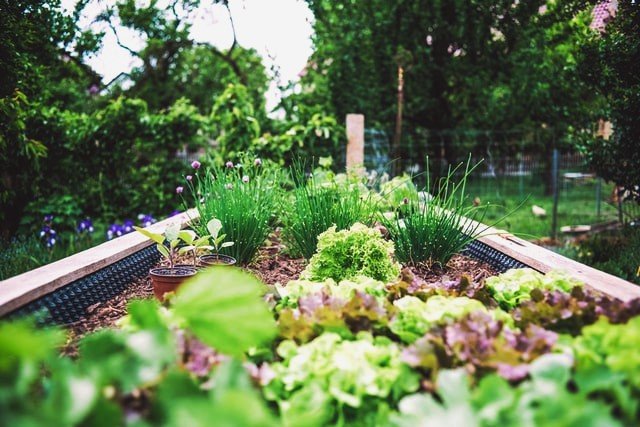
If your choice is raised vegetable garden beds, then you will want to purchase the raised beds or you can build them yourself.
Should you purchase the raised garden beds, you will usually need to decide between timber and steel garden beds. We have an article to help you decide which is best for you: The Best Raised Garden Beds.
But if you are going to DIY your garden beds, you will need to first acquire the timber to create the framing for the raised beds. How much you need depends on how high you want to make the garden beds. Frequently, it is easy to start with below ten inches and then, if required, add another round of planking to raise the height.
You can buy frame kits, and many people successfully repurpose pallet wood as raised vegetable garden frames.
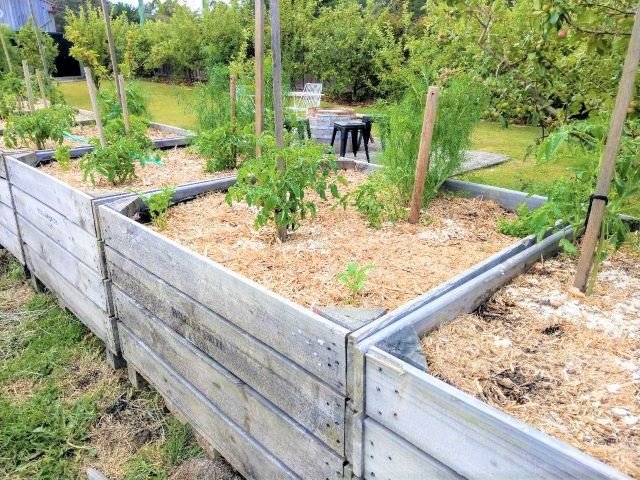
When deciding on the size of the frame, consider that you want to be able to reach the centre of the vegetable bed easily from the outside of the frame. This is an advantage of raised beds; no prepared soil is lost to paths or compaction maximizing the growing capacity of the space.
To create the raised bed areas, you build the frame and place it where you want the raised beds. Depending on your ground underneath, add a layer of small hardcore or vermiculite to aid drainage and then fill with your bespoke mixture of sand, soil, compost and manure.
This method’s advantages include that you create the perfect growing conditions for the vegetables that you want to grow. Because you can grow more densely, there is less opportunity for weeds to grow and the weeding you do have to tackle is easier.
It is easy to manage raised beds with hand tools only and a no-dig system. You can reach all areas from outside the frame, and to top up the nutrients of the soil you simply add additional compost or manure on top.
Related: Soil Calculator For Raised Bed
Vegetable Garden Soil
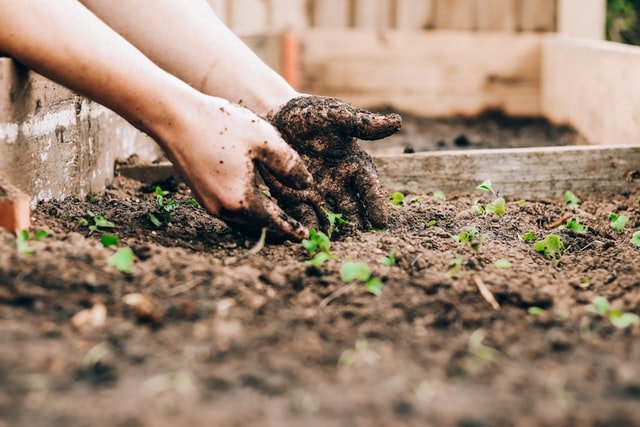
Whichever method you use, the soil that grows your vegetables is the all-important foundation for thriving results.
When you’re are just starting out in vegetable growing, you might think any old soil will grow vegetables. But for happy and healthy vegetable plants, the soil needs to be fed with compost and well-rotted manure. And once you see for yourself the growing power of healthy soil, you too will get excited by the quest for healthy soil!
Most backyards being transferred into vegetable gardens will need improvements to the soil. Adding organic matter conditions and increases soil fertility.
Otherwise, it’s a case of assessing what is there; if the soil is too sandy or has too much clay, the soil will need improving to maximize your vegetable garden growth. If you are buying in topsoil for raised beds or to improve the condition of existing soil confirm and check that the structure is not clay. A sandy soil that you can add compost and manure to increase the condition is a better option.
If you have clay to start with, sand, manure and compost in generous amounts will go a long way to improving the soil and vermiculite, or perlite will increase drainage.
Watering Your Vegetable Garden
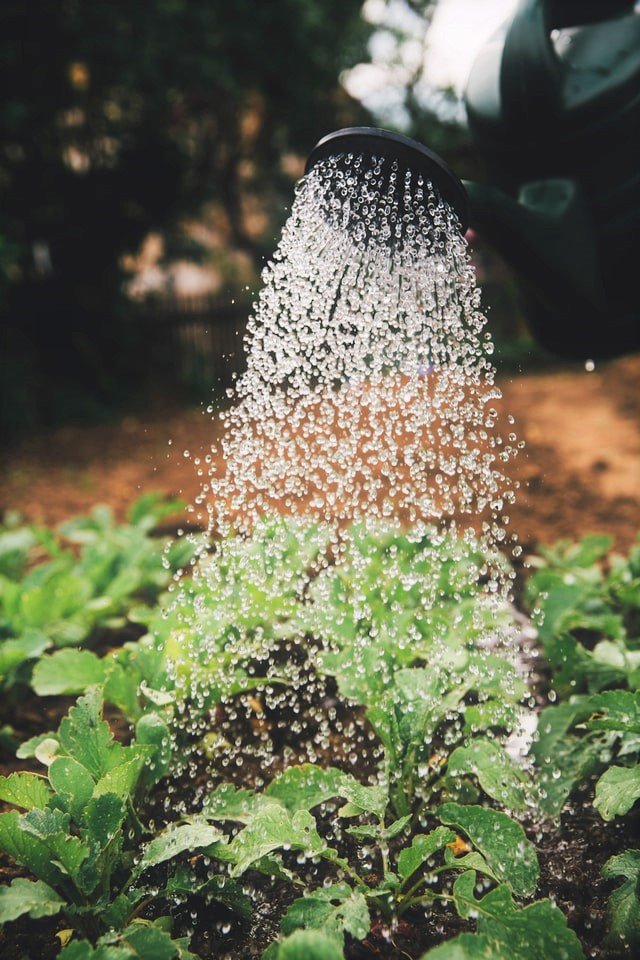
A crucial aspect of growing any vegetable plants is watering them. Think about how far your chosen garden spot is from the nearest tap. Think about your methods of getting water to the plants.
Depending on your location, budget and proximity to the water source, there are several options for watering.
- Drip Irrigation or Soaker Hose
- Watering with a hose by hand
- Watering with watering cans
- Utilize a carefully placed garden sprinkler
Fitting a drip irrigation or soaker hose system is the most efficient way of watering your vegetable garden and is highly recommended for those in the southern hemisphere. It is also the most expensive option, although the system could last in excess of six years once set up. The addition of a timer will take the guesswork out of watering and ensure your vegetables are well watered.
Watering the vegetable garden with a hose by hand can be a highly satisfying experience. As well, you can be checking the condition of plants and keeping an eye out for pests before they become a problem.
Watering with watering cans is the most labor-intensive for a larger garden and most likely the method to lead to the temptation to skip the all-important watering, which is not a good idea. However, for a small vegetable garden or potted plants, a watering can may be the best solution. More details on choosing a watering can in our article: Best Watering Cans.
You can buy a decent metal garden sprinkler that attaches to a hose for a few bucks. By carefully positioning the sprinkler, watering the vegetable garden is simplified.
Remember, watering seeds, seedlings, and young plants is crucial to the success of your vegetable garden. Once established, the plants require less watering.
During the heat of summer, your vegetable garden will normally need watering daily.
What to Grow First in Your Vegetable Garden
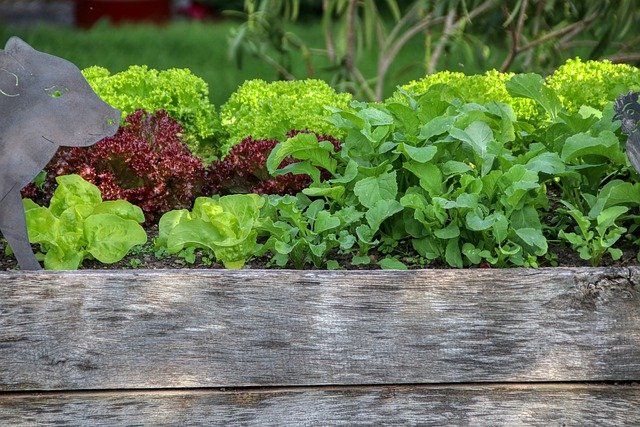
Probably the first rule of what to grow in your vegetable garden is to grow things that you will eat!
If you can, buy seeds earlier in the year, you will get better deals during the winter, get online early for the best prices. If you haven’t bought seeds by the spring, don’t worry; growing from seed is still a very cost-effective way of growing; just plan to get in early next year.
As well as growing what you like, when you first start out, make it as easy as possible for yourself by growing things that are easy to grow.
12 Easy Grow Vegetables:
- Cherry Tomatoes
- Lettuce
- Carrots
- Swiss chard
- Annual Spinach
- Perpetual Spinach
- Zucchini
- Radishes
- Green Beans
- Cucumbers
- Peas
- Kale
I suggest choosing just four to six different vegetables from this list to start with, and if you really cannot decide, then radishes, Swiss Chard, lettuce, and perpetual spinach are probably the easiest to grow. An advantage of perpetual spinach is that it grows year after year and will often continue to produce tasty leaves into the winter in all but the coldest regions.
By staggering the planting of some vegetables that grow quickly like lettuce and radish, you won’t have a glut of them ready at the same time; rather, you extend the harvest time over many weeks.
If you live in an area with a short growing season, then starting off inside is essential to prolong your season as long as possible and specifically look for vegetables with short growing times. Radish and lettuce mature quickly in 6-8 weeks.
Seeds V’s Seedlings for Starting Your Vegetable Garden
When planting vegetables from seed you will probably have to start some inside. This can be on a well-lit windowsill, next to a window of a shed or a cloche. There is no need to think you need a greenhouse for starting plants off. Some seeds sow directly outside.
In the northern climate, tomatoes, peppers, melons will need starting inside and only move outside once the weather is settled and there is no risk of frost. As a rule of thumb, in northern areas, those seeds with a growing time of over ninety days should be started inside.
Those readers in the south have an easier time, with all things starting outside. The downside is ensuring sufficient water to the seeds and seedlings. Some may benefit from being started in a shadier area of the garden before transplanting once established.
When planting the seeds, follow the instructions on seed packets. Remember that you can plant more densely in a raised bed.
Tip: Pay attention to sunlight – tall vegetables and those that you will provide a trellis to grow up will need to be positioned so as not to shade other plants too much.
Buying seedlings to grow in your vegetable garden is a less labor-intensive way of establishing the garden. New gardeners especially, may like this way to get started. The young plants will still need regular watering, weeding, and checking for pests.
Advantages of growing from seed is they are significantly cheaper than buying seedlings.
Weeding your Vegetable Garden
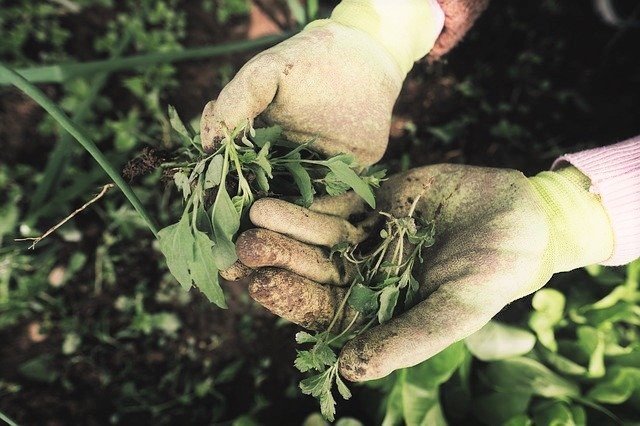
Vegetable gardens benefit from regular weeding to maximize the health and productivity of what you grow. Seedlings especially grow much better if they are not competing with weeds for light, water, and soil nutrients.
As mentioned above, raised beds are generally easier to for weeding, but mulch can help keep the weeds down in traditional growing beds. A suggested plan is to weed weekly and just continue to keep on top of them, so they don’t get out of control. We have more on weeding in our article Natural and Organic Vegetable Garden Weed Control Methods.
Planting Out a Vegetable Garden
Just as there will be instructions on your seed packets for starting the seeds, there should be advice for planting out your vegetable seedlings and plants. If there is not, then these instructions will work with most vegetable seedlings:
- Make sure the soil is weed-free and has be amended with compost and well-rotted manure
- Create a small hole with a trowel
- Gently add the seedling to the hole and carefully secure the soil around the seedling to the height it was in the pot
- Press down gently around the seedling
- Space them out to give them adequate room to reach their mature size
- Water the plants in with a fine watering rose attachment on a watering can, watering the soil near the plant and not directly onto the plant.
- Don’t forget to mulch around the seedlings to help stop the soil from drying out too quickly
Young vegetable seedlings will need careful and regular watering. As the plants grow and establish, watering can usually be reduced in all but the sunniest and hottest locations.
It pays to keep an eye out for any unwanted bugs and treat them with an organic control as soon as possible. Horticultural Neem Oil is very effective.
Conclusion
Anyone can grow a vegetable garden and I hope these guidelines will have you inspired to start your vegetable garden. Remember, for your first vegetable garden, start small while you are learning and you can always expand later. Growing your own vegetables is the most cost-effective way of enjoying fresh, healthy organic vegetables. And you can be confident that the vegetables you eat are not covered in pesticides and artificial fertilizers. A vegetable garden is a fantastic way to connect with nature and enjoy rewarding regular exercise. So why not dig-in today?
Recommended products
- Organic Vegetable Garden Fertilizer
- Soil pH, Water and Light Gauge
- Soil Thermometer
- Organic Seed Raising Soil Mix
- Organic Potting Mix
- Horticultural Neem Oil
Further reading:
- Where to Buy Seeds Online: Herb, Vegetable and Heirloom Seeds
- Planning a Square Foot Garden for Abundant Vegetables
- Best Organic Mulch for the Garden and Natural Mulch Ideas
- Milk Spray Recipe For Powdery Mildew (Natural Fungicide for Plants)
- 30 Surprising Things You Can Compost At Home
